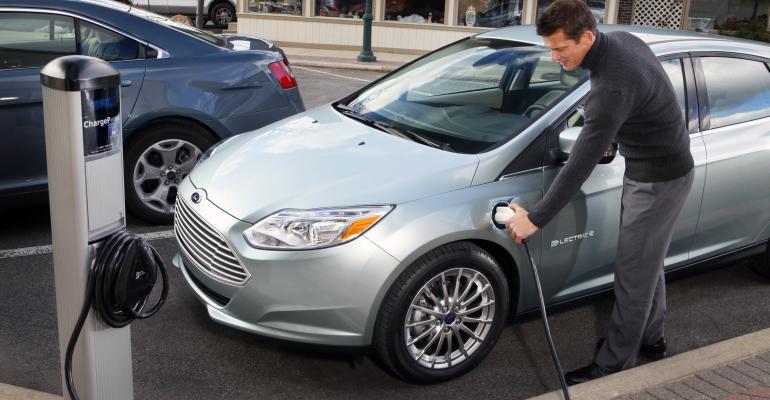WAYNE, MI – Ford is hoping its first all-electric vehicles will sell in large enough volumes to justify bringing future EV development in-house, a top engineer says.
The electric powertrains for the Transit Connect small commercial van and Focus C-segment car were developed by suppliers Azure Dynamics and Magna, respectively. The Transit EV went on sale earlier this year, while production of the ’12 Focus EV has begun at Ford’s Wayne, MI, assembly plant. The car will arrive at dealers in the first quarter.
Sherif Marakby, director of Ford’s electrification programs, says Azure and Magna were tapped to head up the initial EV programs based on their knowledge of such systems and the timeframe in which the vehicles would hit the market.
“Azure already had a lot of the components developed and they are a good company that works on electric-commercial vehicles, so it seemed like a nice collaboration,” Marakby tells WardsAuto at a media event here. “Magna developed the electric-drive portion of the (Focus EV), but the battery and the rest (was developed) in-house.”
Ford has begun development of other components and systems that go into electrified vehicles, he adds, noting core competencies in such technologies are “very strategic.”
The Transit Connect EV is directed toward commercial customers, and low volumes are projected. Focus EV sales goals have yet to be disclosed, but they are expected to be higher than the van’s.
Marakby says if the Focus sells in significant numbers, it would justify bringing future EV development in-house. “We would easily be transferring this knowledge from hybrid and plug-ins, because it’s only half the powertrain. It wouldn’t be a problem to develop the EV completely in-house in the future based on the business case.”
Ford says the Focus EV will achieve the equivalent of 100 mpg (2.3 L/100 km) from its 23 kWh, liquid-cooled lithium-ion battery pack, based on recently released government standards. The vehicle will have a top speed of about 84 mph (135 km/h) and base price of $39,995, but will qualify for a $7,500 federal government rebate.
The Focus EV can be charged in half the time as its top competitor, the Nissan Leaf, using a standard 240V household outlet, Ford says.
Focus EVs to be sold in North America will be built at the Wayne facility plant, while European versions will be produced at Ford’s factory in Saarlouis, Germany.
John Fleming, executive vice president-global manufacturing and labor affairs, says initial annual output for Europe will be in the low thousands. “A lot of this is allowing the European customers to have the opportunity of having full-electric vehicles available,” he says.
Saarlouis production is expected to begin at the end of next year to allow Ford to make the “small tweaks and changes” necessary in the build process based on what is learned at the Wayne plant.
Ford has two additional electrified vehicles on the way, to be built at Wayne; the C-Max hybrid-electric and C-Max Energi plug-in hybrid cross/utility vehicles.
The Energi PHEV will have a 500-mile (805-km) range, besting the Chevrolet Volt’s 375 miles (603 km). Fuel economy figures have yet to be released, but Ford says they will top the Toyota Prius PHEV, which achieves the equivalent of 87 mpg (2.7 L/100 km).
Similarly, the C-Max HEV will best the Prius V in fuel economy, Ford says. The Toyota model gets 44/40 mpg (5.3-5.8 L/100 km) city/highway.
The two C-Max vehicles will benefit from a number of improvements Ford has made to its EV technology, including regenerative brakes that are able to capture more than 95% of the brake energy to help recharge the lithium-ion battery packs.
Both the C-Max plug-in and hybrid are Ford’s first dedicated electrified vehicles. Their body styles will not be offered with conventional powertrains, representing a departure from an earlier strategy to make EV versions with traditional body styles bearing a small badge.
“We think there is a segment of customers that wants to be seen in something different, but also some that are satisfied with the little hybrid label on the car and don’t want to be standing out,” Marakby says.
Both C-Max CUVs will be produced alongside the Focus EV at the Wayne plant beginning next year.
Derrick Kuzak, group vice president-global product development, says Ford is aware of some consumer concern with Li-ion batteries following fires in the Chevrolet Volt extended-range EV during government testing.
He says Ford has taken every precaution to ensure the battery packs in its electrified vehicles will be adequately protected during a crash.
“The battery case, itself, is protected by a strong steel casing that helps provide additional protection beyond the car’s overall safety structure,” Kuzak says. “We achieved our goal of not experiencing damage to any battery cells during our stringent crash-testing regiment.”





